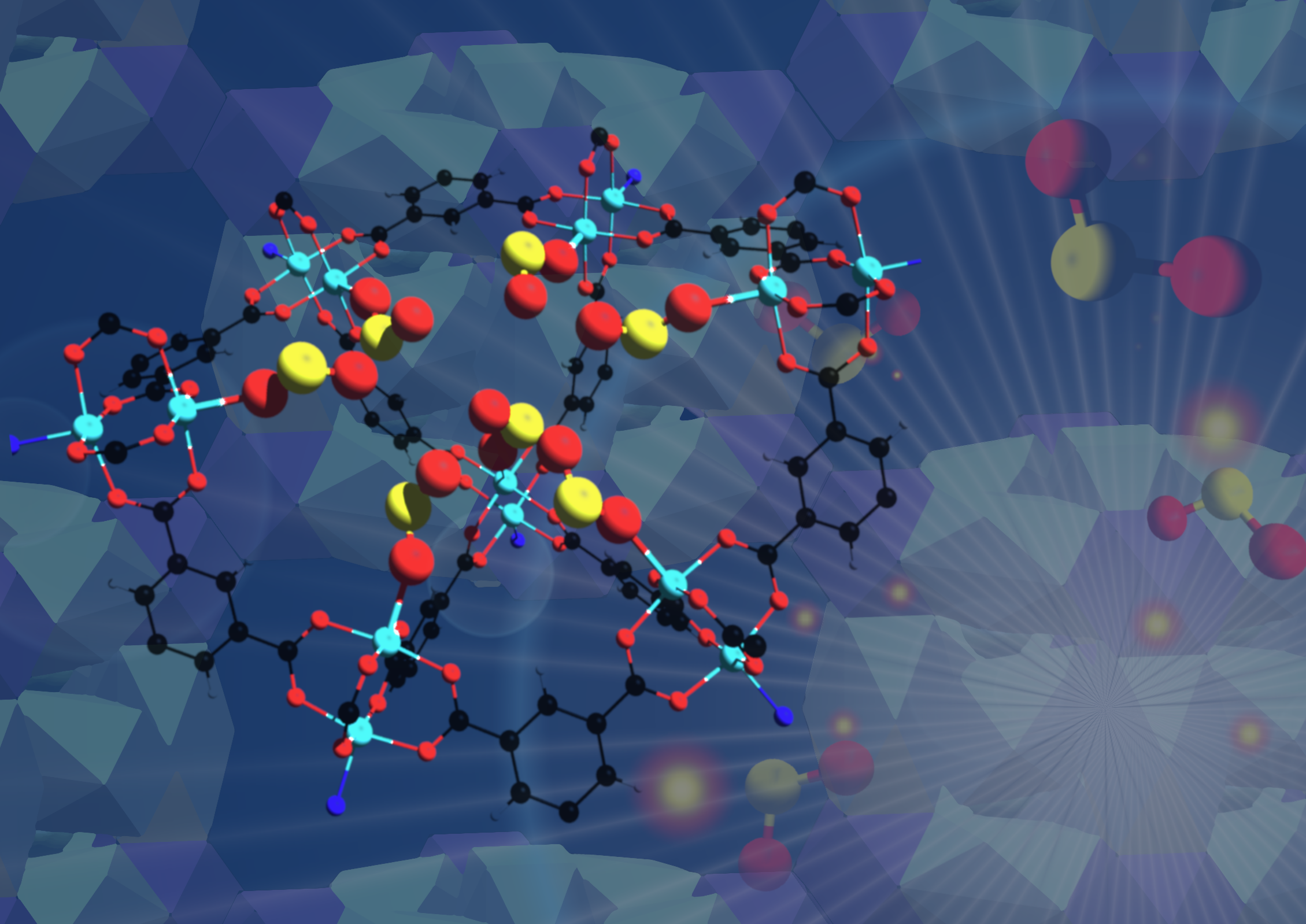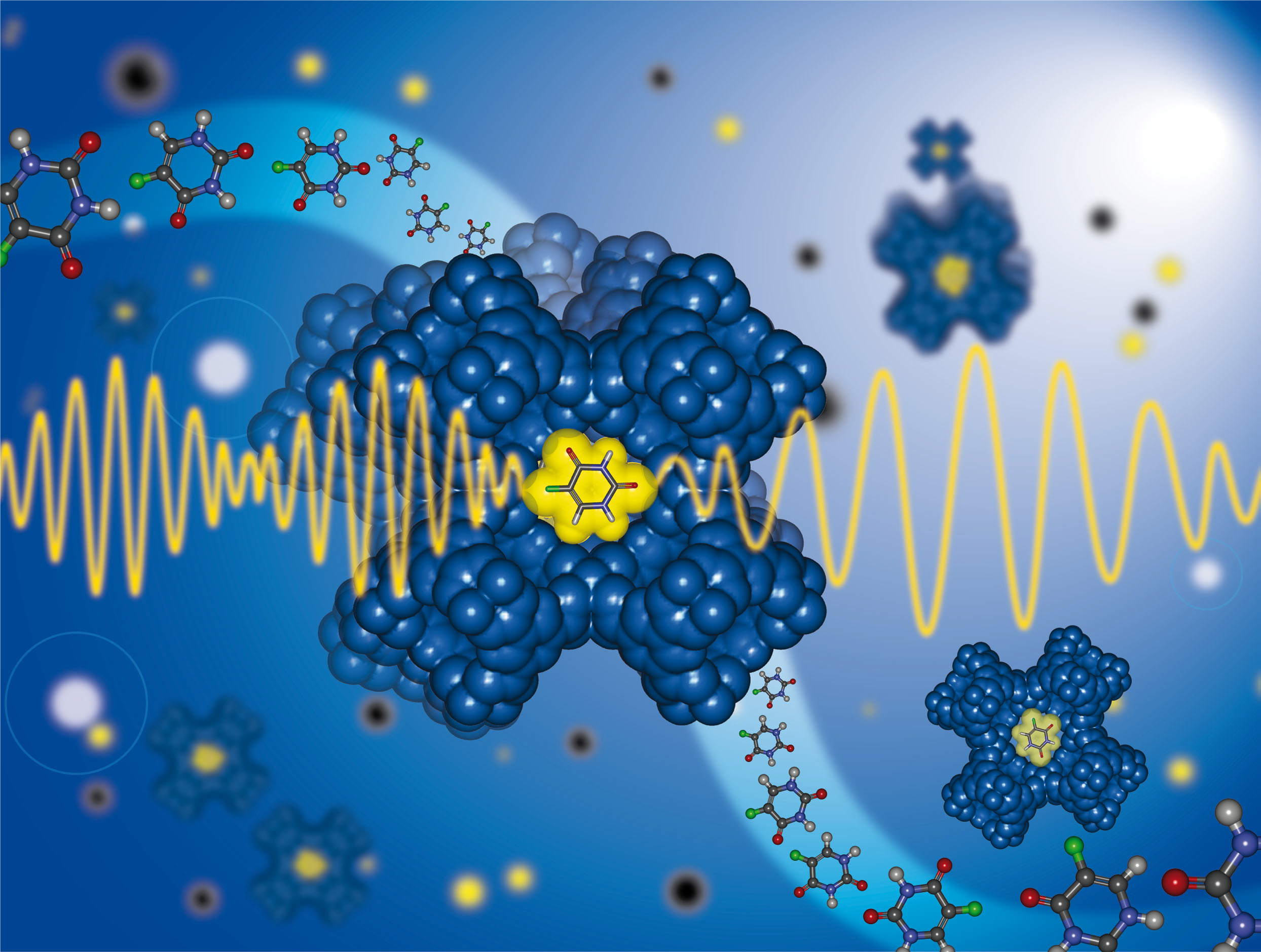Porous materials contain cavities where molecules can bind to the chemical species present on the cavity walls. As the chemistry of these species is changed, so are their preferences for binding different molecules, making them ideal for solving a range of chemical challenges from drug delivery to toxic gas capture.
Using neutrons
Neutron scattering techniques are often used to determine what happens to the guest molecules inside these materials, and find out how and where the guest molecules interact with the walls of the cavities. Such knowledge will allow the design of successive generations of porous materials with enhanced functionality.
Often the molecules we want to trap, such as hydrogen or carbon dioxide, are small. This makes them very difficult to see using X-rays at a university or synchrotron facility. However, neutrons interact differently, and enable scientists to study these small molecules and where they bind within the structure.
As well as knowing where the molecules are bound, it is important to understand why the material binds some molecule but not others. This selectivity is crucial to knowing whether you can practically use a material in a particular application, or if it would get blocked by molecules you are not looking to capture.
Another key feature that is often needed is the ability for the adsorption to be reversed. This enables the material to be used in one environment to adsorb a particular molecule, but then release it later, allowing the material to be used more than once.
Many different groups of researchers visit ISIS every year to study porous materials, using a range of neutron instruments and techniques to investigate their structure, binding and stability. This article highlights just a few examples of these experiments from the last few years.
Zeolites
Zeolites are found in nature where volcanic rocks react with alkaline groundwater. They are made up of AlO45- and/or SiO44- units, with metal ions loosely held within the framework. Because of the relative sizes of the different holes in the structure, they can act as a molecular sieve, sorting molecules based on their size.
They are structurally robust, cheap and are widely used in many industries. Neutron techniques at ISIS have been used in many different experiments studying zeolites and their behaviour.
Zeolites can still be used to separate molecules even when they are similar sizes: their chemical functionality going beyond the sieve-like structure. This is because they can be designed with specific functional groups that selectively bind to some molecules over others.
 For example, researchers from the University of Manchester have used neutron diffraction on the WISH beamline to study the structure of zeolites that selectively bind alkynes such as acetylene. To build on their knowledge of this system, the group also used inelastic neutron scattering to understand the binding dynamics of the adsorbed molecules, as shown in the graphic on the right. Their studies enabled them to use the zeolites to separate alkynes from olefins, or from carbon dioxide: both processes which are necessary in the chemical industry but currently use complex techniques that are very energy-intensive.
For example, researchers from the University of Manchester have used neutron diffraction on the WISH beamline to study the structure of zeolites that selectively bind alkynes such as acetylene. To build on their knowledge of this system, the group also used inelastic neutron scattering to understand the binding dynamics of the adsorbed molecules, as shown in the graphic on the right. Their studies enabled them to use the zeolites to separate alkynes from olefins, or from carbon dioxide: both processes which are necessary in the chemical industry but currently use complex techniques that are very energy-intensive.
In addition to their applications in separation, the large surface area caused by the presence of pores in a zeolite makes them efficient catalysts for chemical reactions. The zeolite ZSM-5 is used industrially to make propene from long chain terminal alkenes. The catalysis company, Johnson Matthey, has used OSIRIS and TOSCA to study how the reactivity towards the propene product changes as the zeolite evolves from the fresh material.
A key challenge in the petrochemical industry is creating long chain organic compounds from environmentally-friendly sources, such as biomass. Zeolites are just one way this chemical challenge could be solved, and researchers have come to ISIS to study new possible materials.
One study used quasi-elastic neutron scattering to look into the behaviour of biomass lignin molecules when they are in contact with a hydro-deoxygenation catalyst made of metal nanoparticles supported on a zeolite. This reaction enhances the energy content of the fuel produced, and so understanding it selectivity and yield is crucial to determining whether the process is industrially viable.
Other zeolites studied at ISIS have been shown to convert biomass into butenes, and another recent study looked into the changes to the microenvironment inside a zeolite that are needed to maximise the conversion of methanol into propene. On this occasion, the adsorption and reaction experiments were carried out in situ on the TOSCA and MAPS beamlines, using inelastic neutron scattering to study the vibrations of the adsorbed molecules and determine the reaction mechanism.
This is another area that is of interest to Johnson Matthey, with recent research using inelastic neutron scattering on TOSCA and MAPS to study the gases present at different stages of the methanol‐to‐hydrocarbons reaction in the presence of the zeolite catalyst ZSM‐5.
ISIS has also been used to study different methods of zeolite formation. The majority of zeolite synthesis routes use organic additives that promote the zeolite to assemble in different ways. Inelastic neutron scattering on TOSCA was used to understand the purpose of these organic additives during the synthesis, with the aim of developing new methods to make novel zeolite structures in the future.
MOFs
Metal Organic Frameworks (MOFs) are a class of compounds that form large porous structures based on metal ions or clusters joined by organic linkers. The coordination properties of the metal, and the chemical make-up of the organic linker means these structures can be tuned so that the pores become favourable sites for particular molecules to bind. Favourable bonding means that the MOF can act as a sponge, absorbing molecules and, in some cases, releasing them under different conditions.

Metal Organic Frameworks (MOFs) have applications in gas storage and separation due to their sponge-like structure. The applications of these MOFs range from industrially-relevant chemical processes to supporting the green industrial revolution.
One study used neutron diffraction on the WISH beamline to study the locations in a MOF where carbon dioxide could bind, while another, shown on the left, studied the real-time adsorption of sulphur dioxide, to see how it could be removed from waste gas streams and used as an industrial ingredient.
Also considered for carbon dioxide storage are flexible MOFs such as ZIF-7. Using quasi-elastic neutron scattering on IRIS and inelastic neutron scattering on TOSCA, researchers investigated the structural changes seen in MOF ZIF-7 when it adsorbs CO2. They found that this change occurs as the molecules move through the structure rather than, as expected, the pores opening.
Ammonia is being considered as an energy vector in a future green economy, and groups from the universities of Oxford and Manchester have both used instruments at ISIS to study the structure of MOFs when ammonia molecules are bound within their pores. These investigations show the importance of the presence of particular functional groups in making the material suitable for ammonia storage and, in one case, converting ammonia to hydrazine.
Another possible energy vector is hydrogen, which can be used in a fuel cell to generate electricity. The polymer Nafion is the most currently used material for membranes in fuel cells, but hybrid MOF materials could also be an option, and research carried out on IRIS narrowed down their possible candidates.
Related to MOFs are a family or materials known as Metal Organic Polyhedra (MOPs), which are also porous materials that could offer a solution to the storage of carbon dioxide. Using neutron diffraction on WISH, researchers carried out a detailed structural investigation into a family of MOPs, finding that one member of the family could successfully adsorb both carbon dioxide and methane.
 Another potential application of MOFs is in drug delivery. The MOF MIL-100(Fe) can trap and release molecules such as drugs in a controlled manner. However, its synthesis involves toxic ingredients, hindering its widespread application. Researchers have used inelastic neutron scattering on TOSCA to understand their recently developed environmentally-friendly synthesis route. To complement their neutron studies, the group also used a range of techniques in the ISIS Materials Characterisation Lab to fully characterise the material and its stability under different conditions.
Another potential application of MOFs is in drug delivery. The MOF MIL-100(Fe) can trap and release molecules such as drugs in a controlled manner. However, its synthesis involves toxic ingredients, hindering its widespread application. Researchers have used inelastic neutron scattering on TOSCA to understand their recently developed environmentally-friendly synthesis route. To complement their neutron studies, the group also used a range of techniques in the ISIS Materials Characterisation Lab to fully characterise the material and its stability under different conditions.
Another investigation by the same research group used low frequency vibrations to probe the interactions between an anti-cancer drug and a MOF that can be used to encapsulate it. By understanding this process of encapsulation, as shown in the figre on the right. they hope to improve the synthesis process so that their MOFs are formed in the same process as the drug molecules are included.
Moving forwards
The examples listed above are just a few instances where neutron techniques have been applied to the study of porous materials. By developing an increased knowledge of their structure and adsorption properties, it is hoped that these materials can be used commercially across a range of applications to reduce damage to the environment, create greener routes to synthetic fuels and developed improved drug delivery mechanisms.
